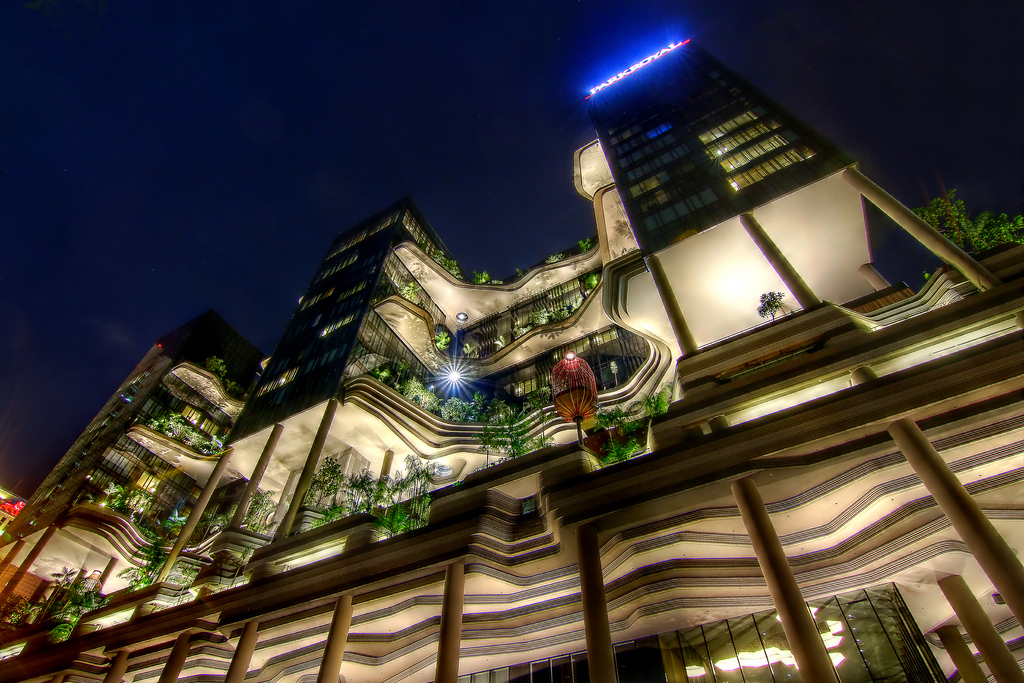Singapore's Parkroyal on Pickering not only has tiers of greenery draped in its contours, but the ample open air space for the outdoor plazas and gardens at the base of the building make it look like the hotel is floating. The design allows the building to max out on space: The 15,000 sm of plantings, water features, waterfalls, terraces and green walls come out to 215% of the site's area.
This week, the Council on Tall Buildings and Urban Habitat (CTBUH) named the Parkroyal on Pickering the Urban Habitat Award winner for 2015. The award, which was founded in 2014, recognizes tall buildings' contributions to the urban realm.
The five-star hotel and four other finalists were chosen "for their exemplary designs that are intelligently influenced by both their environmental and cultural context, and which add to the social sustainability of both their immediate and wider settings," according to a CTBUH press release.
The winners and finalists will be celebrated at an awards ceremony at the Illinois Institute of Technology in Chicago on November 12. The symposioum will have presentations from the owners and architects of each building.
The four other finalists were:
• Chatswood Transport Interchange (CTI) in Sydney, Australia
• d’Leedon in Singapore
• Jing An Kerry Centre in Shanghai, China
• Tour Carpe Diem in Paris, France
Related Stories
Sports and Recreational Facilities | Feb 20, 2015
Chargers, Raiders propose joint stadium in Carson
Two rival teams may bring the NFL back to Los Angeles.
Cultural Facilities | Feb 20, 2015
‘Floating’ park on New York’s Hudson River moves one step closer to reality
The developers envision the 2.4-acre space as a major performance arts venue.
Multifamily Housing | Feb 19, 2015
Is multifamily construction getting too frothy for demand?
Contractors are pushing full speed ahead, but CoStar Group thinks a slowdown might be in order this year.
Architects | Feb 19, 2015
Illustrator Federico Babina imagines architecture from nowhere
The illustrator imagines architecture where past, present, and future intertwine.
Codes and Standards | Feb 18, 2015
USGBC concerned about developers using LEED registration in marketing
LEED administrators are concerned about a small group of developers or project owners who tout their projects as “LEED pre-certified” and then fail to follow through with certification.
Multifamily Housing | Feb 18, 2015
Make It Right unveils six designs for affordable housing complex
BNIM is among the six firms involved in the project.
Office Buildings | Feb 18, 2015
Commercial real estate developers optimistic, but concerned about taxes, jobs outlook
The outlook for the commercial real estate industry remains strong despite growing concerns over sluggish job creation and higher taxes, according to a new survey of commercial real estate professionals by NAIOP.
Museums | Feb 18, 2015
Foster + Partners' National Museum of Marine Science and Technology breaks ground in Taiwan
The museum will be home to an aquarium, exhibition space, and waterfront views.
University Buildings | Feb 18, 2015
Preparing for the worst: Campus security since Virginia Tech
Seven years after the mass shootings at Virginia Tech, colleges and universities continue to shake up their emergency communications and response capabilities to shootings and other criminal threats.
Office Buildings | Feb 18, 2015
Why the mobile workplace isn't always mobile
Perkins+Will’s Janice Barnes addresses the nuance in mobility types and explains the importance of defining terms upfront.














